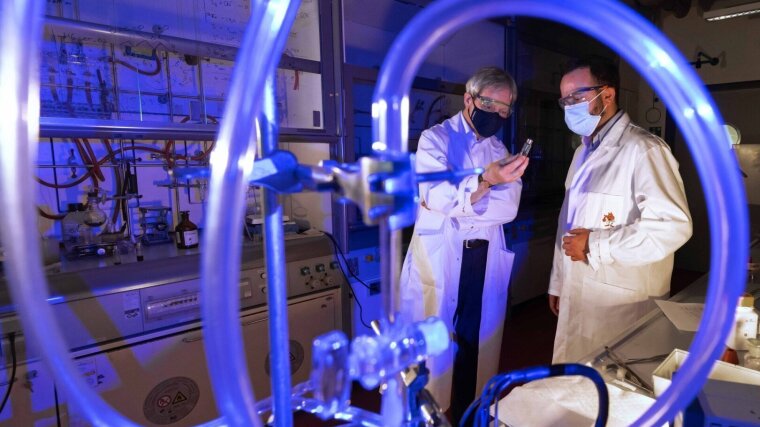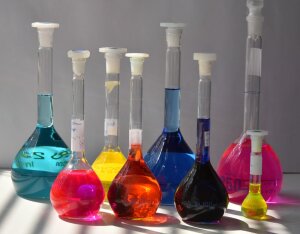
Hydrogen has long been considered a beacon of hope for the energy transition - especially during the ongoing energy crisis. However, hydrogen can only really be seen as a sustainable source of energy if it is obtained from water with the help of renewable energy. How such »green« hydrogen can be produced – preferably from the available solar energy – is being researched at the University of Jena in the »CataLight« Collaborative Research Centre.
By Marco Körner
Even though hydrogen owes its name to water, in practice it is usually obtained from natural gas. This process however produces carbon dioxide. Depending on whether the carbon is released into the atmosphere as a greenhouse gas or is captured and stored, the hydrogen obtained in this process is referred to as »grey« or »blue«. There is also »turquoise« hydrogen; this is where heat is used to split natural gas (methane) directly into hydrogen and solid carbon.
Whether green, grey, blue or turquoise, producing hydrogen requires energy, which ultimately determines how sustainable the energy source actually is. However, green hydrogen will ideally solve a problem that is often attributed to renewable energy sources: fluctuations in availability. Depending on the time of day and the weather conditions, solar power plants and wind turbines can deliver more or less energy than is actually needed. The possibility of storing excess energy in the form of hydrogen and using it elsewhere when required is one of the things that makes hydrogen such a promising source of energy.
Following in nature's footsteps
Obtaining hydrogen straight from water and sunlight is the main goal pursued by the scientists in the Transregional Collaborative Research Centre 234 »CataLight« at the University of Jena and Ulm University. They are following in the footsteps of Nature, so to speak, inspired by the way in which plants use photosynthesis to convert sunlight into chemical energy. The photochemical systems that are being developed and researched in the Collaborative Research Centre require a high degree of expertise and cooperation between a wide variety of departments.
Prof. Dr Kalina Peneva and her research group are working on rylene dyes that absorb sunlight and help to obtain hydrogen from water.
Image: Anne Günther (University of Jena)From water to hydrogen
As photons (i.e. light particles) are governed by the laws of quantum mechanics, the quantum mechanical properties of the chemical systems that are hit by the light have to be understood in great detail. The desired chemical photosystems, on the other hand, are often difficult to recreate in the laboratory. And finally, the photosystem is used to supply energy to a specially designed catalyst with as little loss as possible, so that water can ultimately be converted into hydrogen. This cooperation between various sub-disciplines of chemistry will ideally result in a system that not only generates the coveted source of energy from sunlight and water, but is also inexpensive, durable and robust.
The question of how dyes are quantum-chemically excited by light is being researched by Prof. Kalina Peneva as part of the »CataLight« project. The chemist and her team are focusing on »rylene dyes«, which offer advantages over common dyes based on metal complexes containing iridium or ruthenium – purely organic rylene dyes can withstand light more effectively and are also less expensive.
Prof. Wolfgang Weigand is investigating the chemical step in hydrogen production using the example of »hydrogenases«. These enzymes are used by certain microorganisms that »feed« on the energy source. In order to find out how these enzymes work, Prof. Weigand and his team of chemists are creating model compounds of them, which are then examined in detail down to their quantum mechanical properties. Prof. Stefanie Gräfe and her team are responsible for examining the compounds at the level of theoretical chemistry.
But even though there are already some systems that can generate hydrogen from water by irradiation with light, there are still many obstacles affecting their practical implementation. After all, sunlight contains light of different wavelengths, including harsh UV radiation, which has to be endured by such a chemical system. And in everyday life, water is actually more than just H2O – it contains salts, suspended particles and other compounds in different compositions that can influence the photochemical system. Last but not least, such a system also has to be cost-effective and producible in large quantities.
Catalyst for interdisciplinary research
In this way, hydrogen is not just a beacon of hope for industry and business, but also a catalyst for interdisciplinary research. The »CataLight« project brings together researchers not only from the University of Jena and Ulm University, which are providing the spokespersons in Prof. Benjamin Dietzek-Ivanšić and Prof. Sven Rau, but also the Max Planck Institute for Polymer Research in Mainz, the University of Vienna, the University of Mainz, the Technical University of Kaiserslautern and the Leibniz Institute of Photonic Technology in Jena.
It remains to be seen how long it will take for hydrogen to become established as a real source of energy. But if it comes to that, hydrogen might be given a whole new colour again.
